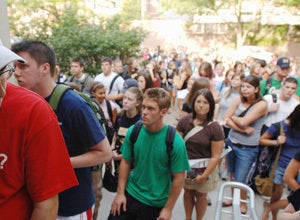
(Part of Huffington Post's America Needs Jobs series; see the introduction.)
There are two age groups that have been particularly devastated by the deep and ongoing unemployment crisis in America: Young people who can't get their first job, and old people who fear they've had their last.
The older workers who've been laid off present society with a real pickle. It's very hard for them to find jobs that fit their skills and experience -- and they face plenty of age discrimination to boot. There are no easy answers for them -- though we'll explore the problem further in the coming days.
By contrast, there is a relatively simple solution for the vastly larger number of young people who can't find jobs in the first place: Put them to work doing something. Anything. You don't even have to pay them that much.
There are nearly 4 million people ages 16 to 24 who are not in school and are looking for work but can't find it. That's an unemployment rate of 18.1 percent. And that doesn't even count the 1.5 million or so more (another 6 or 7 percent) who have given up the job hunt entirely.
"Young people have been getting killed in the labor market," says Heidi Shierholz, an economist at the Economic Policy Institute.
According to the latest monthly job numbers, while 16- to 24-year olds make up only 13.6 percent of the labor force, they account for 25.6 percent of the total unemployed.
"The numbers are quite stunning about how much of the brunt of the recession is borne by young workers," said Harry Holzer, an economist at Georgetown University.
And what makes it even worse is that they aren't able to bounce back once the immediate crisis is over.
"Recently, there's been a lot of evidence about how they get scarred when they try to enter the labor market in the middle of a bad recession," he said. "They're going to be badly hurt by this. If they do connect to the market, it's likely they'll get a worse job than they otherwise would have gotten. And it may be impossible for them to ever make up for the loss. Their whole profile has been shifted down.
"Anything we can do for them that gives them some combination of paid work experience and skill enhancements is really best for them," Holzer told The Huffington Post.
The ideal solution is a program where they get a credential, or some job-training, and to that end Holzer supports government funding to subsidize apprenticeships and on-the-job training.
But any kind of public service employment, "even if there isn't a huge component of skill building" is still better than nothing for young people who don't have any other options.
Late last year, the Center for American Progress issued a report calling for a new commitment to national service, particularly aimed at poverty services -- sort of a kill-two-birds-with-one-stone" approach.
"[N]ational service is as much about unlocking potential as it is about meeting needs," the report said. "It is not just a strategy to create short-term jobs, but rather a proven pathway to create long-term employment opportunities for youth who might otherwise remain jobless or employed in dead-end, low-skill jobs."
CAP's bottom line: "[F]or less than $1.5 billion, Congress could engage close to 150,000 individuals in national service for a one-year term of service at a cost of less than $14,000 per member."
Specifically, the report recommended increased investment in AmeriCorps, VISTA, and youth groups like YouthBuild:
YouthBuild is an example of a youth corps model that focuses on secondary education. YouthBuild members rebuild their lives while rebuilding low-income housing. Participants are 16 to 24 years of age and face multiple challenges....
AmeriCorps engages recent college graduates and veterans in public service while also providing substantial funds for youth corps and other program models. All AmeriCorps members receive Segal AmeriCorps Education Awards when they complete their terms of service. These awards can be used to pay back loans or pay for college or graduate school.....
VISTA participants -- about half of whom have some college experience or a college degree -- build the capacity of non-profit agencies while receiving a poverty-level living allowance, health and childcare benefits, and Segal AmeriCorps Education Awards. VISTAs help nonprofits raise funds, develop new programs, build community partnerships, and recruit and manage volunteers. In short, they could greatly increase nonprofit organizations' capacity to serve low-income people affected by the economic downturn as well as the long-term poor.
Former CEO Leo Hindery recently made this proposal in his Huffington Post blog:
For the 3 to 5 million unemployed out-of-school youth, a group that burgeons in size every summer when another 6.4 million young people graduate from high school and college, a broad-based Municipal Youth Initiative that draws from our previous successful experiences with VISTA and CETA.
Yale economist Robert J. Shiller is calling for a New Deal-style approach that doesn't just create jobs, but inspires the public:
Consider one of the most applauded of Roosevelt's programs, the Civilian Conservation Corps, from 1933 to 1942. The program was open to young men, initially those 18 to 25, a group that was quite vulnerable economically. The C.C.C. emphasized labor-intensive projects like planting trees.
The public appreciated the tree planting because the projects addressed big problems that had been ignored. Major dust storms in and around Oklahoma raged from 1930 to 1936, denuding whole regions of agricultural land. The storms were vivid evidence of an externality that environmentalists had warned about for years, to little avail. Unregulated farming and lumbering had allowed pervasive soil erosion.
Aside from the environmental benefits, the C.C.C. encouraged a sense of camaraderie, taught young men new skills and gave its workers a sense of participation in something historic.
Congress has recently set plans for tripling the size of AmeriCorps, the modern counterpart of the C.C.C., which now takes both sexes and has no age cap. At its peak, the C.C.C. employed 500,000 young men. Under current plans, AmeriCorps would top out at 250,000 people in 2017, even though the nation now is two and a half times larger. We ought to be bolder.
It was the passage of the late Senator Ted Kennedy's national service bill last April that paved the way for the tripling of Americorps -- but that's actually by 2017.
Part of former union leader Andy Stern's overall jobs plan is "Full Employment for Our Children: AmeriCorps and the Kennedy National Service bill 'On Steroids'."
Till von Wachter, an economics professor at Columbia University, made another important point in his testimony before the Joint Economic Committee in May, namely that young people will need to be flexible -- and mobile -- to take full advantage of job opportunities as the economy improves. To help with that, he recommends funding career counseling and job training now, "to provide new skills appropriate for a changed labor market situation" in the future. For instance:
Subsidies could be given for programs involving on-the-job training, which provide work experience and direct contact with employers; subsidies could be given for enrollment in Community College courses; or vouchers could be provided that allow workers to choose ways to up-grade skills on the private markets.
Across the country, the American Dream seems increasingly out of reach. But nowhere is it in greater danger than among today's unemployed young people, who threaten to become a lost generation.
For these young people, especially those at the bottom of the economic ladder, a year-long job in public service could make the difference between a life of employment and a life of unemployment. At $14,000 a pop, doesn't that sounds pretty cheap?
*************************
COMING MONDAY IN THE AMERICA NEEDS JOBS SERIES: Green Is Good
(Want to learn more about the series? Read the overview. Got an idea you think we may have overlooked? Email froomkin@huffingtonpost.com.)
*************************
Dan Froomkin is senior Washington correspondent for the Huffington Post. You can send him an e-mail, bookmark his page; subscribe to RSS feed, follow him on Twitter, friend him on Facebook, and/or become a fan and get e-mail alerts when he writes.
